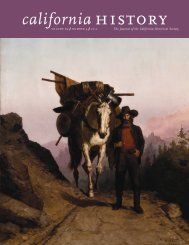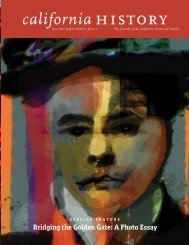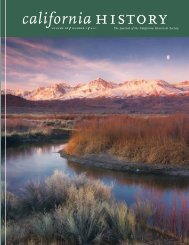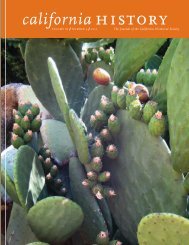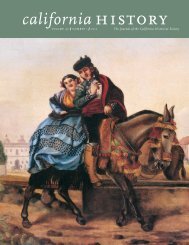california history - California Historical Society
california history - California Historical Society
california history - California Historical Society
You also want an ePaper? Increase the reach of your titles
YUMPU automatically turns print PDFs into web optimized ePapers that Google loves.
on Telegraph Avenue. According to Time, thepolice opened fire on Granma’s rooftop becausean object had been thrown from an adjacentbuilding. Similarly, Alan Blanchard, a twentynine-year-oldfather of a three-month-old son,was standing atop the building where he worked,the Telegraph Repertory Cinema—between thesource of the hurled objects and the location ofGranma’s—when shots were fired at him. 47A Ramparts report, approved by former FBIagent Bill Turner, described the actions of afifteen-man squad of county deputies headed bySergeant Louis Santucci: “The deputies stiffened.Eight or nine of them (according to an analysisof a number of photographs taken at the time)aimed their shotguns at the rooftop. A count ofthe spent shell casings visible afterward on thepavement indicates that at least nine shots werefired.” The photographs published in Rampartsrevealed that only one of the policemen actuallyhad fired at the building from which the missileshad been flung. Rector was shot in the side as hewas turning to run and was saved from rollingoff the building by a <strong>history</strong> graduate student,Michael Meo. He suffered abdominal, chest, andheart wounds. Surgeons removed his spleen, onekidney, and part of his pancreas; nevertheless, hedied four days later from undetected damage tohis heart. Blanchard was permanently blinded byshots that damaged both of his eyes. Aside fromRector and Blanchard, Newsweek noted severalother wounded innocent bystanders: “the wife ofa local bakery shop owner, a 14-year-old boy, andtwo reporters.” 48Six years earlier, Sheriff Bull Connor had shockedthe nation when he opened fire hoses on civilrights demonstrators in Birmingham, Alabama.After Bloody Thursday, Dr. Henry Brean, whotreated the victims of gunshot wounds at nearbyHerrick Hospital, suggested that Sheriff Madiganscale his notion of “law and order” at least backto Sheriff Connor’s level. Brean complained:“There are ways of solving disputes of this naturewithout killing people. Birdshot can penetrate thesoft tissues of the body and sometimes damagethe inner organs. Buckshot tears the body—allof it—apart. The indiscriminate use of shotgunsis sheer insanity. Hasn’t anyone here ever heardof fire hoses?” Initially, sheriff’s deputies deniedthe use of buckshot, admitting only to usingbirdshot. After Rector’s autopsy revealed thathe was, indeed, the victim of buckshot wounds,even Madigan was forced to acknowledge itsuse, although he claimed buckshot was issuedonly after birdshot ran out. In an article in Commonwealmagazine, Charles Horman suggested:“Buckshot is far more dangerous—but the sheriff’sevasion blurs the point that they should havebeen using neither.” 49At the end of Bloody Thursday, forty-eight peoplehad been arrested and sixty-two were hospitalized.Forty-three demonstrators and bystanders,mostly victims of gunshot wounds, had receivedmedical treatment, as well as nineteen policeofficers, including CHP officer Albert C. Bradley,who suffered a stab wound in the chest. Thosewho were detained in Santa Rita Prison Facilitylater filed a class-action suit in Federal DistrictCourt for the Northern District of <strong>California</strong>against Madigan and the Alameda County Sheriff’sdeputies. Judge Robert Peckham respondedwith a restraining order, which prohibited Madiganand his deputies from threatening physicalviolence, using abusive and obscene language,and repeating such acts as “striking prisonerswith clubs and hands; forcing prisoners to beface down on a hard asphalt courtyard coveredwith gravel for periods up to four hours; preventingprisoners from sleeping by continued torment;forcing one prisoner, in full view of otherprisoners, to place his head against a woodenpost and then striking the post with great forceuntil the prisoner’s nose was bloody; cuttingthe hair of one prisoner; preventing at least oneprisoner from getting required medication.” Fortheir use of shotguns and abuses such as these, <strong>California</strong> History • volume 88 number 1 2010



